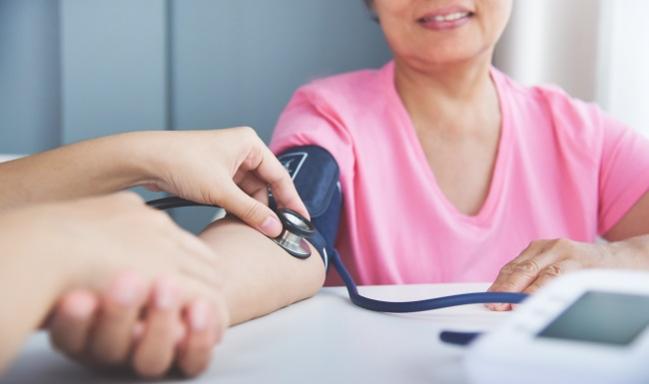Newly Defined Stage 1 Hypertension Tied to CVD Risk in Younger Chinese Adults
Blood pressure readings in the new category were not, however, related to any adverse outcomes in those 60 and older.

The latest US hypertension guideline caused controversy when it moved the bar lower for defining stage 1 hypertension—to a systolic BP of 130 to 139 mm Hg or a diastolic BP of 80 to 89 mm Hg, but a new study out of China shows that blood pressures in this range are strongly associated with CVD risk, at least in younger adults.
In people ages 35 to 59, in fact, 26.5% of CV deaths and 13.4% of incident CVD events were attributed to newly defined stage 1 hypertension, according to lead authors Yue Qi, MD, PhD, and Xueyu Han, MD (Beijing An Zhen Hospital, China), and colleagues.
Stage 1 hypertension was not, however, associated with risk of adverse outcomes in Chinese adults 60 and older, the researchers report in a study published online ahead of the September 11, 2018, issue of the Journal of the American College of Cardiology.
“Broad strategies are needed to facilitate the detection of stage 1 hypertension in young and middle-aged individuals, whereas more evidence is needed before this threshold is applied to individuals age ≥ 60 years,” they say, concluding that the study “provides important evidence on the cardiovascular risk associated with stage 1 hypertension and foundational data for future health economics studies, which are deemed essential if adoption of this new hypertension definition is to be considered in China.”
Age Comes Into Play
Redefining stage 1 hypertension was one of the more controversial aspects of the new hypertension guideline released late last year by the American College of Cardiology (ACC), the American Heart Association (AHA), and nine partnering organizations, and the Europeans did not follow suit when they updated their own guidance this year.
Qi, Han, and colleagues note that “the rationale for the application of stage 1 hypertension hinges on the impact of this blood pressure stratum in a population, including the risk of BP progression, the risk of CVD, and the benefit of treatment and its cost-effectiveness.”
Thus, the investigators set out to assess the relationship between BP in the new stage 1 hypertension range and CVD risk among younger and older adults in China, where the burden of hypertension is high. The analysis included 21,441 individuals 35 or older (mean age 48 years; 48% women) who were free from CVD at baseline and were followed for up to 20 years as part of the Chinese Multi-Provincial Cohort Study. Most participants (90%) were younger than 60. In the overall cohort, 25.8% had stage 1 hypertension as defined by the latest US guideline.
The relationship between BP and outcomes differed based on age. For people younger than 60, the presence of stage 1 hypertension—versus blood pressure below 120/80 mm Hg—was associated with incident CVD (HR 1.78; 95% CI 1.50-2.11), coronary heart disease (HR 1.77; 95% CI 1.33-2.36), and stroke (HR 1.79; 95% CI 1.45-2.22), as well as CVD mortality (HR 2.50; 95% CI 1.66-3.77).
No significant relationships between stage 1 hypertension and those outcomes were found in people 60 and older, however.
When looking at changes in blood pressure over a 15-year period in people with multiple measurements, nearly two-thirds of individuals ages 35 to 59 who initially had stage 1 hypertension progressed to more severe hypertension. Those who progressed had a 3.01-fold greater risk of incident CVD compared with those who maintained blood pressure below 130/80 mm Hg. People who maintained blood pressures in the stage 1 hypertension range over time had a 2.28-fold greater risk, whereas those who dropped out of stage 1 hypertension had a risk similar to that seen in people who maintained a low blood pressure throughout the study period.
“It is anticipated that early detection of stage 1 hypertension and subsequent intervention should retard BP progression, maintain vascular health, protect against organ damage, and ultimately lower CVD risk,” the authors say, noting that “lifestyle changes should be the cornerstone of the management of stage 1 hypertension.”
Caution When Looking at Older Group
Commenting for TCTMD, William Weintraub, MD (MedStar Washington Hospital Center, Washington, DC), said he thinks the observations gleaned from the study are true, but added that “I’d be a little bit skeptical” about the findings in the older age group.
The weaker association between mild hypertension and CVD outcomes in older versus younger people makes sense, he said, because it’s consistent with prior research showing that even though CV risk continues to climb with age, the relative risk tied to hypertension declines.
But to support his skepticism about how much should be read into the findings in the older age group, Weintraub pointed to the small number of people 60 and older included in the study, problems with measurement highlighted by the fact that only 250 older people completed multiple BP readings over 15 years, and the related issue of regression dilution bias, in which measurement problems will impede the ability to find an effect tied to a given exposure.
The study therefore cannot be considered definitive, he said.
Should China Adopt the US Hypertension Guideline?
Hypertension is a major problem in China, and management of the disease has fallen short even of the standard in the United States, which also hasn’t controlled high blood pressure optimally, Weintraub said. And there are questions, he said, about whether China should be looking at adding a new blood pressure stratum to target when there are still problems with getting patients below older thresholds, such as 140/90 mm Hg.
“Whether we should adopt the ACC/AHA 2017 guidelines in China, the jury is out,” Weintraub said. “I believe in being more aggressive in the treatment of hypertension, but I think that we’ve got to get everybody that has blood pressure over 140 mm Hg treated first.”
For people older than 60, it’s probably fine to continue to using the higher threshold when thinking about treating hypertension, but, Weintraub argued, “for younger people where the relative risk really is larger, I think you make a very, very good case—at least in the developed world—for aggressive treatment of [stage 1] hypertension, and ultimately I think we’ll get there in the developing world as well.”
Sandra Taler, MD (Mayo Clinic, Rochester, MN), a member of the writing committee for the US hypertension guideline, had a bit of a different take.
“The whole concept of the article is whether the guidelines would be appropriate to adopt in China, and I think that the data do support that,” Taler, who wrote an editorial accompanying the study, told TCTMD.
She said that even though this is an epidemiologic study, these data are compelling and indicate that “young people are not free of risk and over time they progressed in severity of their hypertension and there also would be a benefit from treating them.”
For most people with stage 1 hypertension, lifestyle interventions would be the main management approach, she said, those who have already had a CV event or who have diabetes or chronic kidney disease, medication would be appropriate.
Looking to the older group, Taler said data from the SPRINT trial supports the benefit of being more aggressive with treatment in everybody, even those 75 and older. She said she puts more weight into that than into the lack of a relationship between stage 1 hypertension and CVD in the current study.
“The balance is in the side effect profiles and the potential risk for falls or hypotension and frailty of older people and what they’ll tolerate,” Taler said. “But still I would have to say that I think that SPRINT was a very well-done trial . . . and I don’t think we can throw that away and say it doesn’t count. So I think that’s stronger evidence definitely than the epidemiologic evidence.”
The overall message of the current study should be that “blood pressures between 130 and 139 mm Hg systolic and 80 to 89 mm Hg diastolic are not harmless, and there is a risk for cardiovascular events if left untreated as well as a likelihood that they’ll progress to more severe hypertension,” Taler said.
Lifestyle modification should be stressed for all patients in this range, she said, adding, however, that for older people, drug treatment might potentially be considered because the 10-year cardiovascular risk in that group is likely to be more than 10%.
Todd Neale is the Associate News Editor for TCTMD and a Senior Medical Journalist. He got his start in journalism at …
Read Full BioSources
Qi Y, Han X, Zhao D, et al. Long-term cardiovascular risk associated with stage 1 hypertension defined by the 2017 ACC/AHA hypertension guideline. J Am Coll Cardiol. 2018;72:1201-1210.
Taler S. Epidemiological versus trial evidence for hypertension treatment: adding a piece to the puzzle. J Am Coll Cardiol. 2018;72:1211-1213.
Disclosures
- Qi, Han, and Taler report no relevant conflicts of interest.
- Weintraub reports having a grant from the National Institutes of Health to do further modeling of the SPRINT data.


Comments